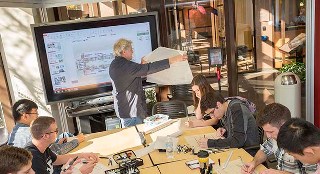Dec 22 2014
What was once the stuff of science fiction is now an educational tool students in Ball State University’s architecture, planning and landscape architecture programs are incorporating into daily life.
 Bruce Race, CAP professor, shares design plans with visiting expert and alumnus Jeremy Brown. Brown was able to make himself telepresent in Race’s class via StudioBot technology.
Bruce Race, CAP professor, shares design plans with visiting expert and alumnus Jeremy Brown. Brown was able to make himself telepresent in Race’s class via StudioBot technology.
Guillermo Vasquez de Velasco, dean of the College of Architecture and Planning, said the school’s new robotic technology gives students the benefit of working with professionals in a way they’ve not done previously by opening opportunities to routinely consult with not only their instructors but working professionals as well.
“This is learning without limits,” Vasquez de Velasco said. “The use of this technology is bordering on revolutionary, because of the ease with which it allows our students to meaningfully interact with working professionals anywhere in the world, with no more coordination than an email requires.”
What makes the so-called StudioBot different from existing technologies such as video conferencing, said Vasquez de Velasco, is the ability for the robot to move seamlessly throughout a classroom and interact one-on-one with a student at his or her workspace. And because the equipment is controlled remotely, on-site professors are free to continue group instruction, without having to worry about moving the robot from one student desk to another.
With the ability to carve out even a few minutes here and there, professionals are no longer prevented from volunteering their expertise by scheduling conflicts or travel expenses. Some businesses or entities such as airports have incorporated static versions of the technology that operate like information kiosks, but the interactivity of a robot in the classroom changes the dynamic of distance instruction.
“This provides students access to experts and long-distance support,” said Bruce Race, FAIA, FAICP, and associate professor of professional practice at Ball State. “It’s one tool in the kit and great for one-on-one interaction.”
The immediacy of the communication appealed to Kaitlyn Forbes, 22, a graduate student from Albany, New York.
“The robot provides more real-time feedback and more useful feedback,” Forbes said, because experts are focusing on only one project at a time, asking questions and offering suggestions tailored for each student’s work.
Jeff Neulieb, 22, a graduate student from LaPorte, Indiana, agreed the interaction with the experts via the robot was natural and appreciated.
“The interaction between us felt pretty normal,” Neulieb said. “It’s personal. The instructor was right here with me at my desk. By using the bot, we can get people to give better insight because they are looking at what we’re doing right now.”
Vasquez de Velasco said he’s also pursuing opportunities for distance-learning students to use the bot. “This technology would allow students to roll into any class,” he said. “I think we need to think in a progressive way, this is real time and face-to-face.”
While Vasquez de Velasco said there are huge benefits for students to live and study in a campus environment, there are instances where the ideal is simply not possible. Telepresent robots create new opportunities, he said, that change how colleges and universities could consider a student’s enrollment status.
“The content via a telepresent robot will be as rich and robust as if the student were present physically in the classroom,” he said. “The possibilities this presents are almost limitless and very exciting.”